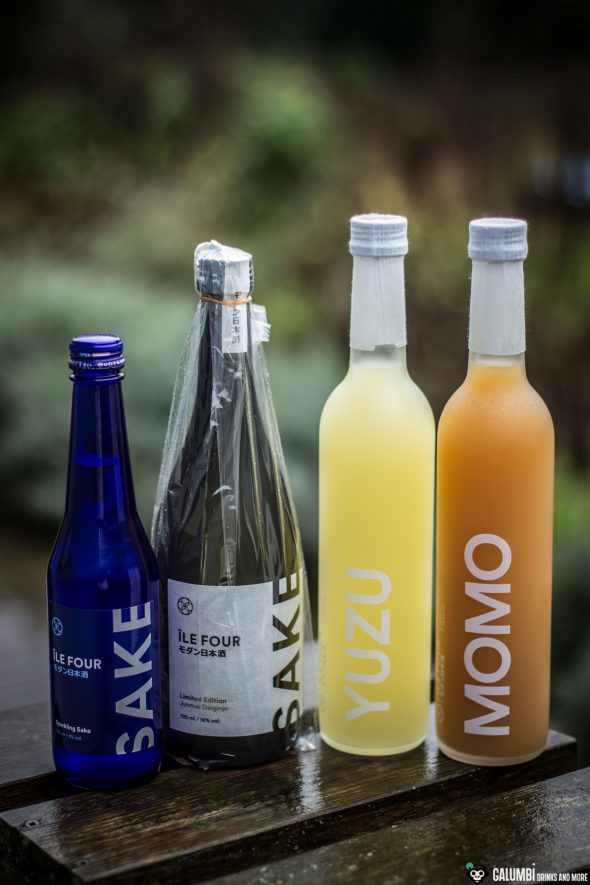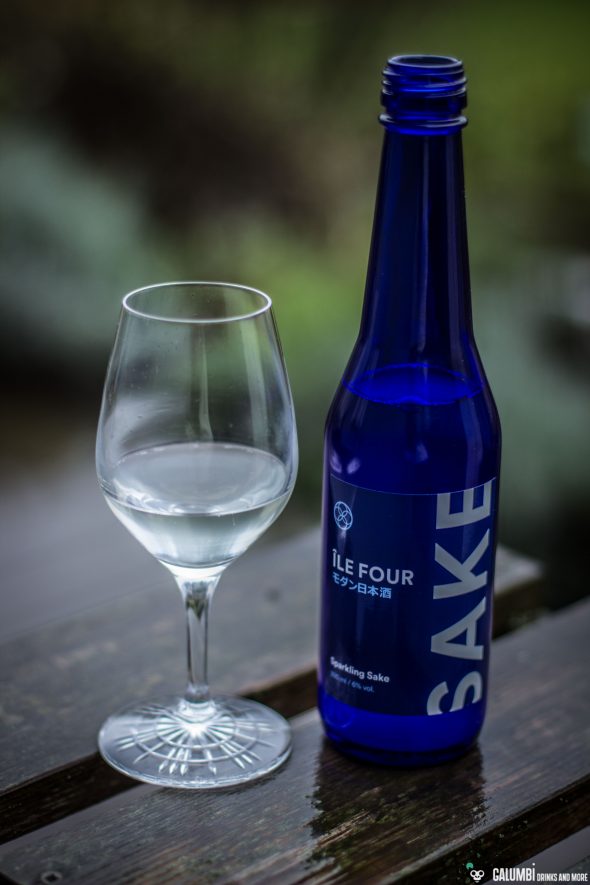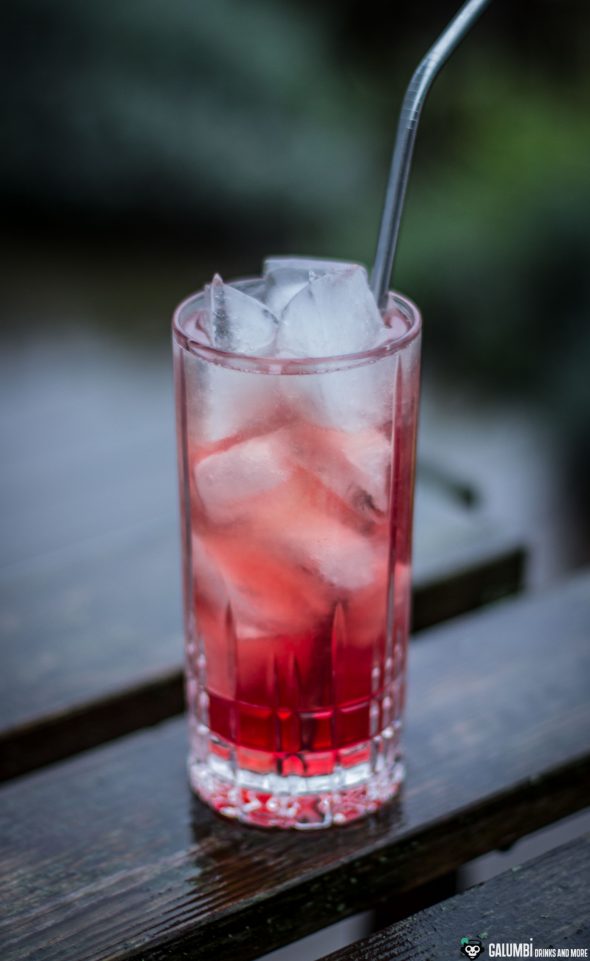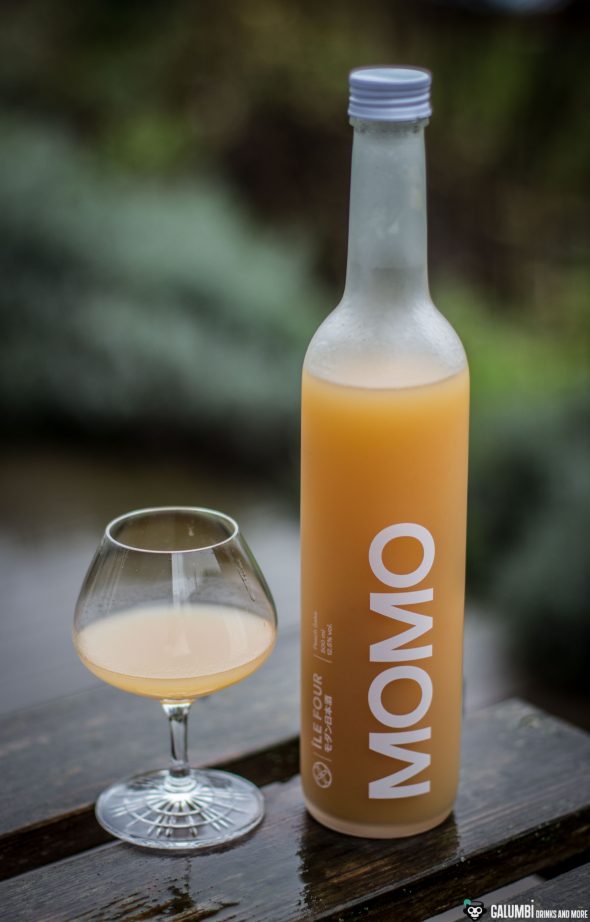
First of all, I wish all readers a happy new year 2019! Moreover, I’m entering 2019 here on the blog in a Japanese way. Once again, I would like to deal with Japanese bottlings, which recently found their way to me and which are expanding the range of Japanese products available. These are several bottles bearing the name Île Four, which at first sounds little Japanese. (provided test products)*
Île Four means as much as “four islands” and is an allusion to the four Japanese main islands Honshu, Shikoku, Kyushu and Hokkaido. Well, and indeed we are dealing here with a number of different sake bottlings and according to the manufacturer the name was deliberately chosen to underline the idea of the product line: to improve the Western availability of premium sake or Tokutei meishō-shu (特定名称酒).

In fact, good sake is not omnipresent on the European market. Anyone looking for good sake will soon notice that the qualities offered in Asian food markets usually are not what we would expect to be “premium products”. If, on the other hand, your local wine and spirits dealer has a thing for sake or understands something about it, then you can be sure that you are lucky. Often the only way to get your hands on good sake is an online order from a very manageable number of suppliers. Île Four joins this number of suppliers, but wants to cover an unoccupied niche with an attractive and innovative, but above all also pricewise tempting offer according to its own statements. The future will show to what extent this will be successful in the long term. For me, what counts most today is what the products offer in the tasting.
I have already explained the basics of the sake category in a condensed form in another article in the past, so that I would simply like to refer to that overview here. Instead, I want to head directly towards the flagship of the Île Four series which is the Île Four Limited Edition Junmai Daiginjo Sake. This sake was made from Yamadanishiki rice with a polishing rate of 50% (hence the categorization as Junmai Daiginjo). The manufacturer proudly states that the renowned Sake expert John Gauntner ranks this Sake among the three to four percent of the world best Sakes. I will leave this premature praise to speak for itself (even if you have to consider that Tokutei meishō-shu, i.e. premium sake, only covers about a quarter of all Japanese sake production. Although this relativizes the percentage value somewhat, it seems that even within this group the Île Four plays relatively far in the front in Gauntner’s eyes). It is bottled with an ABV of 16% vol.

Tasting Notes “Île Four Limited Edition Junmai Daiginjo Sake”:
Aroma: A beautiful and appealing bouquet of white grapes, some lemon sorbet, honeydew melon, tangy white wine aromas with a fine acidity. These are accompanied by some linden honey and very interesting mineral tones.
Taste: Soft and mild with a finely balanced sweetness and subtle acidity, white peach, light grapes, gooseberries, honeydew melons, mineral notes reminiscent of healing waters and again a hint of lime honey.
Finish: rather dry and unbelievably soft with associations of a Federweisser.
Of course, you can use a beautiful sake in many different ways in cocktails. It has the potential to take the place of a gin or vodka in classic drinks or to accompany them in part. However, the most popular use is certainly as an alternative to white vermouth. Because I always find it difficult to use a nice sake with its wonderfully subtle and harmonious complexity in superimposed drinks, I chose the Sakura Martini invented by Kenta Goto from New York’s Bar Goto. In this variant of the classic Martini, the sake is stirred with a gin (I opted for the KI NO BI Kyoto Dry Gin) and is then flavored with a hint of maraschino. That’s all. Simple, elegant, somehow typical Japanese and absolutely appropriate for the Île Four Junmai Daiginjo.

Sakura Martini
Recipe “Sakura Martini” (after Kenta Goto, New York):
7 cl Île Four Limited Edition Junmai Daiginjo Sake
3 cl KI NO BI Kyoto Dry Gin
4-5 drops Maraschino
Preparation: Stir all ingredients until cold in a mixing glass on ice and finally strain into a pre-cooled glass.
Glass: Coupette or Martini
Garnish: cherry blossom (unfortunately I had none)
***

Besides a Junmai Ginjo Sake and an unfiltered Junmai Nigori Sake, Île Four also offers a carbonated “Sparkling Sake”. This sake, which is produced based on a “lightly unfiltered” Junmai Sake according to the manufacturer’s specifications, ferments a second time in the bottle, as we know it from champagne production, for example. And that is also a proper direction of thinking about this sparkling sake with an ABV of 6%: as an alternative to sparkling wines or as an ingredient for cocktails, which I personally find very interesting and exciting! Nevertheless, I don’t want to miss trying it neat!
Tasting Notes “Île Four Sparkling Sake”:
Aroma: Again I do find a potpourri of white grapes and other light fruits with a mineral note and a slight sweetness. However, it is not as multidimensional as the Île Four Limited Edition Junmai Daiginjo Sake.
Taste: The Sparkling Sake has a rather fine but full-bodied perlage that clearly brings the sweet notes of sake to the fore. Here, again the characteristic mineral notes with white wine tones, grapes, white but still unripe peaches are present and again I feel reminded of Federweisser, which I already had with the Junmai Daiginjo.
Finish: sweet, rather short
For the Green Mango Cocktail, I oriented myself in the above-mentioned sense by classic champagne cocktails, but I still went slightly different paths. Basically, it is a Gin Smash infused with Sparkling Sake, fresh coriander green and fully ripe mango. Since the sweetness of a mango is not always reliably calculable, the amount of sugar in the recipe may have to be slightly changed, but for my purposes the 0.5 cl were absolutely sufficient.

Green Mango Cocktail

Recipe “Green Mango Cocktail”:
3 cl Jinzu Gin
1,5 cl lime juice
4 cubes ripe mango (approx. 2cm x 2cm)
0.5 cl sugar syrup
½ Hand full of fresh coriander green
Île Four Sparkling Sake
Preparation: Put all ingredients except Île Four Sparkling Sake into a shaker and crush the mango cubes with a muddler, taking care that the coriander green is not completely shredded. Finally fill with ice cubes and shake vigorously. Double-strain into a pre-cooled glass and fill up with Île Four Sparkling Sake.
Glass: Champagne
Garnish: dried slice of mango
***
The Île Four portfolio also includes very modern “Fruit Sakes”. Here the varieties Yuzu (who doesn’t know the Asian citrus fruit?), Momo (Momo peaches) and Ume (Ume apricots, as they are mainly known from Umeshus) are offered. The name “Fruit Sake” is a little problematic in my opinion, because it is neither a sake brewed with fruit additives, nor a blend of sake and fruit juice. A look at the list of ingredients of the two varieties “Yuzu” and “Momo” provided to me for this article reveals that the sake content is in the single-digit percentage range and is only an addition to a mixture of water, fruit juice, sugar and brewing alcohol. Well, whether the designation is a good one or not: in the end, many liqueurs are produced in a very similar way and still enjoy an outstanding reputation. And of course these “Fruit Sakes” seem to me to be of great interest especially for the use in cocktails. Both bottles have an ABV of 10.5 %

Tasting Notes “Île Four YUZU”:
Aroma: The first impression is that of a lively, fresh and very beautiful, freshly cut and slightly sweetened yuzu fruit.
Taste: Not too sweet, relatively well integrated fruit, but not particularly complex. A fruity, lively drink, not much of the contained sake can be found here, however.
Finish: fruity and rather short with fine fruit acidity.
When I hear the word Yuzu, I think spontaneously and almost automatically of the spicy, refreshing taste of the fruit – and have therefore chosen a simple Highball, which also offers a lighter alcohol content. To make this drink, the Île Four Yuzu is mixed with soda water, a small shot of Mondino Amaro Bavarese (in an emergency, switch to Campari, even if it doesn’t give the same result) and bitters. The bitter-spicy orange note from the Mondino bestows complexity and depth upon that highball. I named the drink after the common nickname for Japan: “Rising Sun Highball”.

Rising Sun Highball
Recipe “Rising Sun Highball”:
5 cl Île Four YUZU
1.5 cl Mondino Amaro Bavarese
1 Dash The Bitter Truth Peach Bitters
soda water
Preparation: Pour all ingredients except for the soda water into a glass filled with ice cubes and finally top off with the soda water.
Glass: Highball
Garnish: none
***

Tasting Notes “Île Four MOMO”:
Aroma: Here, the fragrance of fresh peach puree is particularly evident, relatively sweet, perhaps it lacks a little fruity acidity for the very authentic note, yet nothing artificial can be found here.
Taste: The taste is that of a beautiful, fully ripe peach, which in my opinion is a little too sweet, however. Here, too, little or no sake characteristic is recognizable. The MOMO is rather an interesting alternative to peach liqueurs, but in this context it is quite promising.
Finish: sweet and rather short
Of course, the Île Four Momo can also be used to prepare nice, refreshing drinks (or you can try a Bellini variant, as suggested on the back label). Nevertheless, I wanted to try out how this flavoured “Spirited Drink” (I like the designation better than “Fruit Sake”) performs in a Negroni variant. I combined it with a mature Citadelle Reserve and Campari and really liked the result. It simply gives the drink an unusual, but quite fitting note, which combines beautifully with the barrel aromas of the Citadelle. I simply named the drink Momogroni.

Momogroni
Recipe “Momogroni”:
3 cl Citadelle Reserve Gin
2 cl Île Four Momo
2 cl Campari
1 cl Shochu
Preparation: Add all ingredients to a glass filled with ice cubes, stir, ready.
Glass: Tumbler
Garnish: none
Buying sources: At specialized retailers or online
*The fact that these products have been sent to me free of charge for editorial purposes does not – in any way – imply any influence on the content of this article or my rating. On the contrary, it is always an indispensable condition for me to be able to review without any external influence.
